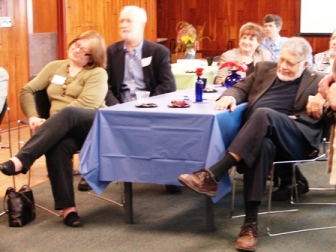Cultural-Communication
Awareness of cultural-communications will improve your team interactions. Use this online-leadership-tool to identify common sources of tensions to get started.

Donna Rae Scheffert, author, and cultural-communication organizational consultant is President of Leadership Tools. She is a former Leadership Development Specialist from the University of Minnesota Extension. She spent over 20 years creating leadership information, tools and training. She is the owner of online-leadership-tools.com and President of Leadership Tools, a consulting company.
Cultural-Communication Concepts
Check out this online-leadership-tool to identify common sources of cultural-communication tensions. Take the intercultural communication assessment alone or with your team. This will provide an excellent start to your discussion about what makes for good communication within your team.
What is cultural communication?
Communication is the sending and receiving of information and often is what trips up people. What people mean by "good communication" is very personal. Edward Hall (Culture Matters), the noted interculturalist maintains that culture is undergirded by communication. Thus, cultural-communication is a basic building block of leadership.
When people from difference ethnic groups are in a team, this is called intercultural communication. Many people expect challenges in these settings. However, miscommunication often happens even when people are from similar cultures. In the cross-cultural context, like everything else, communication is even more complex. It is almost impossible to send a message that does not have at least some cultural content whether it is in words, the way it is said, or in the nonverbal signals that accompany them.
Even if it were possible to send a message without it having a cultural content, it would be impossible to receive without having a cultural content. Thus, good communication is in the ear of the receiver!!

How do I determine my cultural communication preferences?
When you or your group wishes to analyze its cultural communication styles, have each member select one of the pair that they are most like. Then, read the sentence and rate the "degree of the preference." Use a scale from 1 (low preference) to 5 (very strong preference).
For a group profile add each members response per item. It is normal and expected that preferences will be for both responses and for varing degrees of preference. The challenge for the group is to detrmine each individuals preference and how to make the team communications honor the various preferences.
CULTURAL COMMUNICATION ASSESSMENT
MODE of Communication
Below are two cultural-communication choices. Select the one most like you - either a. or b. Rate your choice from 1 (low preference) to 5 (very strong preference).
a. LINEAR "Getting to the point" is very important and the point is stated explicitly. Not getting to the point quickly is seen as a time waster. Communication is conducted in a straight line, moving in a linear way toward the main point. 1 2 3 4 5
b. CIRCULAR Communication is conducted in a circular manner around the main point. The point may be left unstated because the verbal and nonverbal information provided is sufficient for understanding. Stating the point explicitly is seen as insulting the other person. 1 2 3 4 5
FORM of Communication
Below are two cultural-communication choices. Select the one most like you - either a. or b. Rate your choice from 1 (low preference) to 5 (very strong preference).
a. FORMAL
Communication in many respects is highly ritualized-"When in Rome do as the Romans do".Communication is governed by strict rules regarding such things as: forms of address, ways to address persons of different ages and statuses, topics which can and cannot be discussed, etc. 1 2 3 4 5
b. INFORMAL Persons have more flexibility in what they say, to whom they say it, and under what circumstance. Communication is less bound to specific conventions. Informal communication might also be demonstrated by the use of the first name for a professor or another authority figure, for example. 1 2 3 4 5
CONTEXT of Communication
(Surrounding conditions, for example, what was happening when the Declaration of Independence was signed)
Below are two cultural-communication choices. Select the one most like you -either a. or b. Rate your choice from 1 (low preference) to 5 (very strong preference).
a. LOW CONTEXT The context of the communication is not assumed to be known. Things must be explained clearly and unambiguously. Meaning must be expressed precisely. 1 2 3 4 5
b. HIGH CONTEXT The context for communication is assumed to be known. Hence it is unnecessary, even insulting to explain things and state meaning precisely. Meaning is taken from context. 1 2 3 4 5
EMOTIVE EXPRESSION of Communication
Below are two cultural-communication choices.Select the one most like you -either a. or b. Rate your choice from 1 (low preference) to 5 (very strong preference).
a. ATTACHED (Emotive) Communication is carried out with feeling and emotion. Issues are discussed with a degree of passion and commitment. Communication is very expressive. Sharing one's values and feelings about the issues is highly valued. 1 2 3 4 5
b. DETACHED (Non-Emotive) Communication is carried out in a calm and impersonal manner. This is equated with objectivity, which is valued. Highly expressive, emotive, and engaged communication is inappropriate because this is seen as personalizing the issues and as biased. 1 2 3 4 5
FOCUS of Communication
Below are two cultural-communication choices. Select the one most like you -either a. or b. Rate your choice from 1 (low preference) to 5 (very strong preference).
a. IDEA-FOCUSED
The emphasis is on ideas which are seen as separate from the person. Thus, disagreement with another person's ideas is acceptable and even valued. It is not seen as a personal attack. 1 2 3 4 5
b. TASK-FOCUSED
Communication focuses on the task at hand and getting it done. The other person's feelings are secondary. Group harmony is secondary to task completion. 1 2 3 4 5
CENTERING of Communication
Below are two cultural-communication choices. Select the one most like you -either a. or b. Rate your choice from 1 (low preference) to 5 (very strong preference).
a. PERSON-CENTERED
The emphasis is on the person; hence great importance is attached to the feelings of the other person. Issues and ideas are not separated from the person. Thus, disagreement with someone’s ideas must be handled very carefully. 1 2 3 4 5
b. RELATIONSHIP-CENTERED
Communication is focused on relationships. Maintaining group harmony is central. The task is secondary. Task completion must not come at the expense of the group or person. 1 2 3 4 5
Results of Your Preferences
Once each team member has completed their assessment of cultural communication preferences, compare ratings and discuss what this may mean for how you prefer to communicate.
How did you score?
MODE of Communication
FORM of Communication
CONTEXT of Communication
FOCUS of Communication
CENTERING of Communication
Communication Tips

People’s life experiences and cultural backgrounds result in different interpretations, perspectives, and assumptions to actions and statements. In addition to language barriers, there also exist vast nuances, tone of voice, and gestures also impact people’s point of view and understanding when communicating. For example, hugging or hand-shaking may signify friendship and warmth to some and be absolutely taboo to others; saying “no” may be the beginning of negotiation or the bottom line; establishing eye contact may show sincerity or be seen as a lack of respect.
When leading across cultures it’s important to pay attention to communication differences so that participants are able to express themselves most comfortably without appearing discourteous or insulting to others.
Recommendations
Communication is more than just verbatim words. A sense of being respected, valued, and safe needs to be communicated in the environment of the gathering such as:
• Adapt your communication style to communicate better with others.
• Learn about the cultural etiquette of the various group members and adapt appropriately.
• Be astute in reading and interpreting nonverbal behaviors and gestures. Gestures and body language vary and are an intricate aspect in communication.
• Ask questions for clarification of norms and practices, e.g. unwritten rules, from other cultures.
• Accommodate language barriers – including having interpreters and translators for taking notes and so participants can ask questions or respond in their primary language. It is time consuming but creates an accepting, trusting, and respectful atmosphere.
• Use inclusive language – since diversity includes gender, reframe from the use of male dominant language, i.e. men, he, him, etc.
• Suspend judgmental tendency to evaluate statements and actions of other persons. Try to comprehend feelings and thoughts that are behind the expression.
• Recognize high anxiety is common in cross-cultural experiences. Keep a high level of alertness, be patient, and recognize it’s a learning journey.
What can leaders can do to improve cultural-communications?
Communication is always in a cultural context and includes words, intonation, gestures, a continuum of styles, and shared meaning. In order to be effective in communicating in a multicultural setting, a leader needs to know their own style preference as well as being aware of barriers that might prevent a successful experience.
No matter where the leader or participants fall in relation to cultural-communication styles people from that perspective think of it as normal, natural and right. Being astute in the difference styles helps the leader to vary their own communication with the participants. This is the key strategy for intercultural communication.
For consulting or coaching check out Cultural-communication experts at deepSEE consulting

Bring in an experienced expert when you need a:
Trustworthy Source of Facilitation, Training, Strategic Planning
Donna Rae Scheffert
809 Mayflower Ct.
Northfield, MN 55057
Let me assist you and your organization. Call me at 612.360.4484
or e-mail leadershiptools@charter.net
